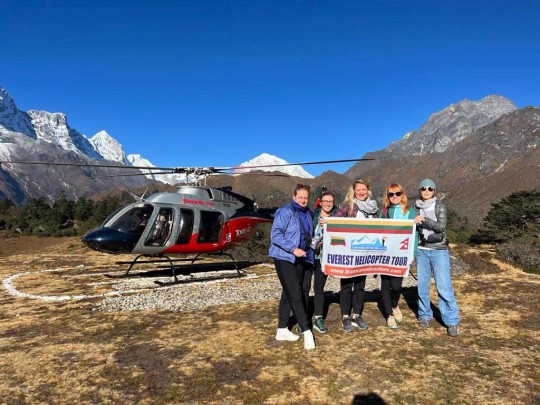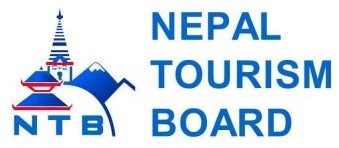- Home »
- Travel Information »
- Comprehensive Guide to Traveling in Nepal (2025-2026)
Comprehensive Guide to Traveling in Nepal (2025-2026)

7th Dec, 2024
- teamramadventure
Nepal, a small yet extraordinary country nestled in the heart of the Himalayas, offers travelers a captivating blend of rich cultural heritage, awe-inspiring landscapes, and thrilling adventure-filled experiences. This landlocked nation, bordered by China to the north and India to the south, east, and west, is home to some of the world’s tallest peaks, including Mount Everest, the highest point on Earth. Nepal has long been a destination that entices tourists from across the globe with its spiritual sanctuaries, bustling cities, traditional villages, remote trekking routes, and vibrant festivals.
Table of Contents
Whether you seek an adrenaline-fueled trek through the Himalayan mountains, wish to explore ancient temples and UNESCO World Heritage Sites, or desire to immerse yourself in the rich culture and traditions of Nepal, this country offers something for every type of traveler. This comprehensive travel guide provides you with everything you need to know about traveling in Nepal in 2025 and 2026, including essential tips, best travel seasons, top destinations, cultural insights, and more.
1. General Overview of Nepal
Nepal is a land of contrasts. It is where the flat plains of the Terai region meet the towering, snow-covered peaks of the Himalayas. Despite its small size, covering only around 147,516 square kilometers, Nepal is home to a population of roughly 30 million people. The country has a rich history, with cultural influences from India, Tibet, and beyond, making it an extraordinary blend of diverse traditions and heritage. Nepal is also notable for being the birthplace of Siddhartha Gautama, also known as Buddha, which makes it an important spiritual center for Buddhists from around the world.
Beyond its cultural depth, Nepal’s landscapes are incredibly diverse. From low-lying plains to the high-altitude grandeur of the Himalayas, the country's beauty is unparalleled. Nepal is home to sacred Hindu temples, Buddhist stupas, ancient medieval towns, and majestic mountains, making it a haven for history buffs, spiritual seekers, and nature lovers alike.
2. Best Time to Visit Nepal
Nepal experiences four distinct seasons: Autumn, Spring, Monsoon (Summer), and Winter. Each season offers its own advantages and challenges, and the best time to visit Nepal largely depends on what kind of activities you wish to enjoy.
2.1 Autumn (September to November)
Autumn is considered the best time to visit Nepal, particularly for trekking and outdoor activities. The weather is clear, dry, and mild, with stunning mountain views and ideal conditions for exploring Nepal’s natural beauty. Autumn is also the peak tourist season, so popular trekking routes and destinations can get busy. However, this season provides the perfect backdrop for hiking in the Himalayas, including treks to Everest Base Camp, Annapurna, and the Langtang region.
2.2 Spring (March to May)
Spring is another great season for trekking, characterized by pleasant temperatures and clear skies. The blooming of rhododendron forests in the Annapurna region during spring adds vibrant colors to the already breathtaking landscape. Spring is slightly less crowded than autumn, making it an excellent choice for those who prefer quieter treks and a more relaxed atmosphere.
2.3 Monsoon/Summer (June to August)
The monsoon season brings heavy rainfall, which primarily affects the central and eastern regions of Nepal. This can make trekking in the mountains hazardous due to muddy trails, slippery paths, and the risk of landslides. However, the Terai region, including Lumbini and Chitwan National Park, experiences less rainfall and is still an excellent choice for wildlife safaris and cultural exploration. If you plan to visit this region, the summer months offer an alternative to trekking.
2.4 Winter (December to February)
Winter in Nepal can be cold, particularly in the higher altitudes, but the Kathmandu Valley and lower regions remain sunny and dry. While trekking at high altitudes, such as Everest Base Camp or Annapurna, can be challenging due to freezing temperatures, the winter season offers magnificent mountain views and fewer crowds. It’s an ideal time for travelers who want a more peaceful and solitary experience.
3. Top Destinations in Nepal
Nepal is a country of remarkable geographical and cultural diversity, and here are some of its most popular destinations that you should not miss:
3.1 Kathmandu Valley
Kathmandu, the capital city of Nepal, is a bustling center of culture, religion, and history. The Kathmandu Valley is home to seven UNESCO World Heritage Sites, including:
- Swayambhunath (Monkey Temple): A Buddhist stupa offering panoramic views of the valley.
- Boudhanath Stupa: One of the largest stupas in the world and a sacred site for Tibetan Buddhists.
- Pashupatinath Temple: A major Hindu temple dedicated to Lord Shiva, located along the Bagmati River.
- Durbar Squares: The historic palace complexes in Kathmandu, Bhaktapur, and Patan feature exquisite architecture, intricate carvings, and historical monuments.
Kathmandu offers a unique blend of ancient traditions and modernity, with bustling markets, spiritual shrines, and vibrant streets. It is also the gateway for trekkers heading to the Himalayan regions.
3.2 Pokhara
Pokhara, located around 200 kilometers west of Kathmandu, is a picturesque city renowned for its serene lakes, panoramic mountain views, and laid-back atmosphere. It is the starting point for several trekking routes in the Annapurna region, such as the Annapurna Base Camp and Ghorepani Poon Hill treks. Top attractions in Pokhara include:
- Phewa Lake: A tranquil lake where you can enjoy a peaceful boat ride surrounded by stunning views.
- Sarangkot: A hilltop offering breathtaking views of the Annapurna and Machapuchare mountain ranges, particularly at sunrise.
- Davis Falls: A beautiful waterfall that flows into a deep cave.
- Gupteshwor Cave: A sacred cave with a famous shrine dedicated to Lord Shiva.
3.3 Chitwan National Park
Chitwan National Park, located in Nepal's Terai region, is one of the best wildlife destinations in the country. The park is home to endangered species like the Bengal tiger, one-horned rhinoceros, and gharial crocodiles. Visitors can enjoy jeep safaris, jungle walks, and boat rides through the park’s rich biodiversity. You can also experience the local Tharu culture by visiting nearby villages.
3.4 Everest Region
The Everest region is famous for being home to Mount Everest, the tallest mountain on Earth. Trekkers flock to the region to experience its stunning landscapes and rich Sherpa culture. Popular treks include the Everest Base Camp Trek, Gokyo Lakes Trek, and the more challenging Everest Three Passes Trek. Visitors can also explore Buddhist monasteries like the famous Tengboche Monastery.
3.5 Annapurna Region
The Annapurna region offers a variety of treks and some of the most spectacular mountain views in Nepal. Notable treks include the Annapurna Circuit Trek, which takes you through diverse landscapes, from subtropical forests to alpine deserts, and the Annapurna Base Camp Trek, which provides views of Annapurna I, Machapuchare (Fishtail), and other peaks. The Ghorepani Poon Hill Trek is a shorter and easier trek that offers stunning sunrise views.
3.6 Langtang Region
Langtang, one of the closest trekking regions to Kathmandu, is known for its scenic beauty, Tibetan Buddhist culture, and excellent wildlife. The Langtang Valley Trek takes you through forests and traditional villages, offering panoramic mountain views. The Gosaikunda Lake Trek leads you to the sacred Gosaikunda Lake, an important pilgrimage site for Hindus.
3.7 Lumbini
Lumbini, the birthplace of Lord Buddha, is one of the holiest Buddhist sites. Located in the Terai region, near the Indian border, Lumbini is home to the Maya Devi Temple, which marks the exact spot where Buddha was born. The peaceful environment and historical significance make Lumbini an ideal destination for spiritual reflection.
4. Cultural Insights and Etiquette
Nepal is a multi-religious country, with Hinduism and Buddhism as the two dominant religions. Understanding the local culture and etiquette is important to ensure respectful interactions with the locals.
4.1 Religious Practices and Festivals
Nepal celebrates numerous festivals throughout the year, which reflect the country's religious diversity. Some of the most notable festivals include:
- Dashain: A Hindu festival that celebrates the victory of good over evil.
- Tihar: Known as the festival of lights, it honors the bond between humans and animals.
- Buddha Jayanti: The celebration of Buddha’s birth, enlightenment, and death.
- Lhosar: The Nepalese New Year celebrated by various ethnic groups, including Newar and Sherpas.
4.2 Greetings and Etiquette
The traditional greeting in Nepal is Namaste (pronounced nah-mah-stay), which is performed by pressing the palms together in front of the chest. This greeting is used for both hello and goodbye. When entering homes or temples, it’s customary to remove shoes. Always ask for permission before taking photos of local people, as this can be considered intrusive.
4.3 Dress Code
Dress modestly, especially when visiting temples or religious sites. Both men and women should cover their shoulders and knees when entering sacred places.
4.4 Tipping
Tipping is not compulsory but is appreciated in Nepal. In restaurants, a service charge may be included, but it is customary to leave a small tip. Trekking guides and porters generally expect tips if they’ve provided excellent service.
5. Practical Travel Tips
5.1 Visas and Documentation
Most visitors to Nepal need a visa, which can be obtained upon arrival at Tribhuvan International Airport in Kathmandu or at land border crossings. Visas are available for 15, 30, or 90 days. You can also apply for an e-visa online before arriving.
5.2 Health and Safety
Before traveling, consult your doctor regarding necessary vaccinations (hepatitis A and B, typhoid, malaria). If you plan to trek at high altitudes, acclimatization is essential to prevent altitude sickness. Always travel with comprehensive travel insurance that includes medical coverage and emergency evacuation.
5.3 Currency and Money
Nepal’s official currency is the Nepalese Rupee (NPR). You can exchange foreign currency at banks or exchange booths. While credit cards are accepted in major cities, cash is essential in rural areas. ATMs are available in larger towns but carry extra cash when trekking.
5.4 Transportation
Public transportation in Nepal is limited, but taxis, buses, and auto-rickshaws are widely available in cities. Domestic flights are common for travel to remote destinations like the Everest region or Pokhara, though road travel can be bumpy and slow in rural areas.
6. Trekking in Nepal
Nepal’s trekking routes are world-renowned, ranging from short, easy hikes to challenging high-altitude treks. Popular treks include:
- Everest Base Camp Trek: A challenging but rewarding trek to the base of the world’s tallest mountain.
- Annapurna Circuit Trek: A classic trek around the Annapurna range, offering diverse landscapes and spectacular mountain views.
- Langtang Valley Trek: A shorter trek offering scenic beauty and cultural experiences.
- Manaslu Circuit Trek: A remote and challenging trek around the Manaslu massif.
Conclusion
Nepal is a country of immense beauty, culture, and adventure. Whether you’re trekking in the Himalayas, exploring ancient temples, or immersing yourself in its rich traditions, Nepal promises an unforgettable experience. By respecting local customs, planning your journey, and embracing its wonders, your trip to Nepal will be filled with awe-inspiring moments and lasting memories.


 Plan Your Trip Now
Plan Your Trip Now 





